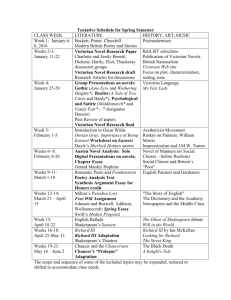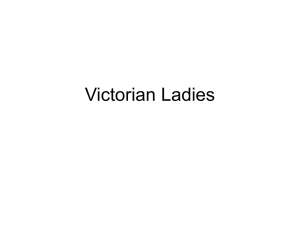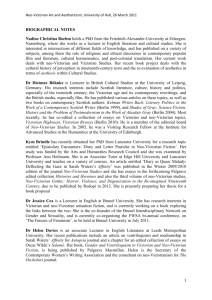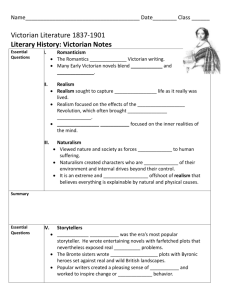Abstracts - University of Hull
advertisement
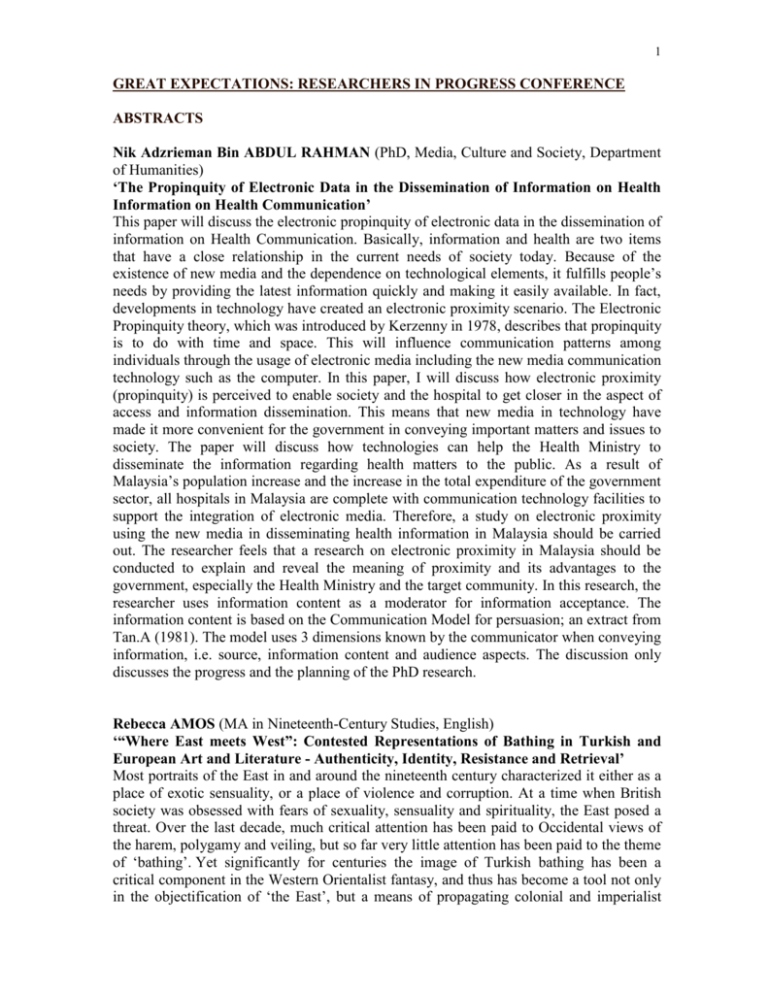
1 GREAT EXPECTATIONS: RESEARCHERS IN PROGRESS CONFERENCE ABSTRACTS Nik Adzrieman Bin ABDUL RAHMAN (PhD, Media, Culture and Society, Department of Humanities) ‘The Propinquity of Electronic Data in the Dissemination of Information on Health Information on Health Communication’ This paper will discuss the electronic propinquity of electronic data in the dissemination of information on Health Communication. Basically, information and health are two items that have a close relationship in the current needs of society today. Because of the existence of new media and the dependence on technological elements, it fulfills people’s needs by providing the latest information quickly and making it easily available. In fact, developments in technology have created an electronic proximity scenario. The Electronic Propinquity theory, which was introduced by Kerzenny in 1978, describes that propinquity is to do with time and space. This will influence communication patterns among individuals through the usage of electronic media including the new media communication technology such as the computer. In this paper, I will discuss how electronic proximity (propinquity) is perceived to enable society and the hospital to get closer in the aspect of access and information dissemination. This means that new media in technology have made it more convenient for the government in conveying important matters and issues to society. The paper will discuss how technologies can help the Health Ministry to disseminate the information regarding health matters to the public. As a result of Malaysia’s population increase and the increase in the total expenditure of the government sector, all hospitals in Malaysia are complete with communication technology facilities to support the integration of electronic media. Therefore, a study on electronic proximity using the new media in disseminating health information in Malaysia should be carried out. The researcher feels that a research on electronic proximity in Malaysia should be conducted to explain and reveal the meaning of proximity and its advantages to the government, especially the Health Ministry and the target community. In this research, the researcher uses information content as a moderator for information acceptance. The information content is based on the Communication Model for persuasion; an extract from Tan.A (1981). The model uses 3 dimensions known by the communicator when conveying information, i.e. source, information content and audience aspects. The discussion only discusses the progress and the planning of the PhD research. Rebecca AMOS (MA in Nineteenth-Century Studies, English) ‘“Where East meets West”: Contested Representations of Bathing in Turkish and European Art and Literature - Authenticity, Identity, Resistance and Retrieval’ Most portraits of the East in and around the nineteenth century characterized it either as a place of exotic sensuality, or a place of violence and corruption. At a time when British society was obsessed with fears of sexuality, sensuality and spirituality, the East posed a threat. Over the last decade, much critical attention has been paid to Occidental views of the harem, polygamy and veiling, but so far very little attention has been paid to the theme of ‘bathing’. Yet significantly for centuries the image of Turkish bathing has been a critical component in the Western Orientalist fantasy, and thus has become a tool not only in the objectification of ‘the East’, but a means of propagating colonial and imperialist 2 ideologies, distancing Turkey as the exotic, ‘irrational other’. The spiritual, rejuvenating nature of Turkish bathing was instantly connected by the British with sexual promiscuity. For patriarchal Victorians, anything that was sensual and spiritual was thus sexual and irrational and a threat to rationality and morality. Yet, simultaneously, the issue of sensuous bathing was also romanticized in Orientalist art and literature of the time, resulting in a complex antithesis of ‘otherness’. In this paper I will examine the various representations of bathing and consider the nature of this multifaceted issue. I will explore the current notion of the Turkish attempting to reclaim this contested ‘space’ as a means of identity retrieval. In doing so I hope to deconstruct the binary between the Occident and the Orient and demonstrate that there is no fixed truth, just different perceptions of reality. In my exploration of these themes I will draw on sources from European Orientalist art, travel writing and dialogues from both Western and Eastern women. Rebecca BAYNES (MA in Women, Gender and Literature, English) ‘“Motherhood is the sign and seal as well as the means and methods of a woman’s bondage”: The rejection of the Maternal Instinct in New Woman Writing’ New Woman writers, and First Wave feminist discourse, identified motherhood as a crucial factor in the construction of women’s image and societal role. I intend to explore the function of the maternal instinct concept in fin-de-siècle fiction and late Victorian society by analyzing three novels by Mona Caird, Olive Schreiner and Victoria Cross. The paper will look at the role of the maternal instinct premise as an ideological repressive conception, the rejection of the maternal instinct by some New Women, and the social response to writing about acts carried by women that contradict the idea of the maternal instinct, such as the neglectful mother and infanticide. Such readings of the novels will show an alternative image of the often preconceived notion of women as naturally maternal and will demonstrate the Victorian New Woman revolt against the singular societal role of mother and caregiver. The paper will refer to other motherhood orientated Victorian rhetoric, such as the idea of eugenics or the empowering purpose of motherhood, to further expose the continuing restrictive traditional framework some New Woman writers continued to utilize. The aim of the paper is to identify the mythical construct of the maternal instinct premise, present a new image of the Victorian woman as anti-maternal and show that many New Women writers identified the ideological concept of the so-called ‘maternal instinct’ as purely oppressive rhetoric. M. A. Kamal BILLAH (MA Gender and Development, Social Sciences) ‘Child Right Policies and Cultural Constructions of Childhood: Emergence of a Paradox’ Dominant discourse of childhood as well as children’s rights evolved from the industrial North having been borne to the South, and in the course of this discourse children are shown, on the one hand, as innocent, docile, helpless, needing protection from pollution by the outside world, and on the other hand as savage and pre-social, requiring strict discipline to develop properly. These faces/images of children that Western societies construct constitute a universal distinctive group underpinning international children’s rights policies. But the ethnographic study of childhood draws attention to different faces/images of children in different cultures. The predicaments of children in the South 3 affected by the onslaught of famine, poverty, war and HIV/ AIDS stand out in sharp relief against the images of children that affluent societies have. Among them, the girl-children constitute a distinctive body of subjects deprived of their right to agency and prone to prejudice, discrimination, exclusion and violence. Child marriage, a gigantic customary evil, pervading the developing world in far large numbers and vast intensity, robs children off their right to happy and uninterrupted childhood and adolescence, their prospects of education, skills development and voluntary consent. In this paper, there will be an effort to discuss, on the one hand, the constructions of childhood in relation to socio-cultural stereotypes of customs and economic conditions of the states, and on the other hand, a new paradigm of childhood that emerges in the course of ethnographic study of childhood. Naomi CROOK (MA in Women, Gender and Literature, English) ‘The Visual Versus the Haptic: The Relationship Between Gaze and Touch in M. Night Shyamalan’s The Village’ The politics of the gaze has long been a well established locus of analysis in film, yet there has been relatively little done regarding the analysis of touch and the relationship it has with the gaze. I intend to highlight that touch, like the gaze, has a set of conventions which can be used to empower the individual. In this paper I aim to analyse gaze politics and touch politics within the narrative of The Village (2004) and find out which of the two are the most powerful. I will look at how both gaze and touch are engendered and I wish to investigate the idea of touch subverting the politics of the gaze. My argument is that the isolating and alienating gaze can be undermined by using touch as a power strategy; essentially removing power from those who cast the gaze. Using examples from The Village (2004) I hope to highlight how the gaze can become powerful particularly when coupled with masquerade and how this power can be subverted when subject of the gaze cannot return it. Furthermore, using the character of Ivy, I intend to stress how using touch as a power strategy can undermine the dominant gaze. Mark ELLIOT (PhD, English and Centre for Popular Culture) ‘Approaching Illustration: A Discussion of Theoretical Models for Reading Image and Text’ This paper aims to address the increasing critical interest in analysing the juxtaposition of image and text in literature. Throughout the late twentieth century some key theorists including Roland Barthes and W. J. T. Mitchell have turned their attentions to readings that mediate between an image and text in order to better understand the meaning structures and processes that underlie such an act. These readings occur in comics, both ‘high’ and ‘low’ illustrated literature, areas such as advertising and fine art, in the titles and descriptions of paintings for example, as well as many instances of more abstract dayto-day occurances. While using important subject studies such as Engraven Desires: Eros, Text and Image in the French Eighteenth Century (Stewart, 1992) and Illustration (J. Hillis Miller, 1994) as a means of negotiating the specific field, this paper will also address studies such as Susan Sontag’s On Photography (1977) and Judith Williamson Decoding 4 Advertisements (1978) in order to augment a structural, semiotic understanding of the subject. The purpose of the paper, therefore, is to give an appraisal of the possibility of moving toward a coherent theory for such a study, the primary difficulty of which comes from the various functions and attributes of a multi-media and interdisciplinary subject. Katie GRAY (MA in English) ‘Altered Minds and Outsiders in the Literature of Wilkie Collins’ When Collins first described the famous encounter of a mysterious woman in white by Walter Hartright, he introduced his Victorian readers to the chilling and exciting world of the Sensation novel. Had Hartright unwittingly aided an escaped lunatic? Why was she so intent on communication with the beautiful Laura Fairlie? As the creator of the first British detective novel, Collins offered his readers The Moonstone. A thrilling tale of deception, intrigue, secrets, suspense and opium. In Armadale, two young Allan Armadales are threatened by their ancestors. Are they destined to become enemies as dreams and past foretell? The literature of Wilkie Collins is fuelled by mystery and dark secrets waiting and feared to be uncovered. The aim of my research is to examine Collins’ fascination with the altered states of the characters he employs to construct his plot. The beautiful, yet deadly, opium-addicted Lydia Gwilt searches hard to be vindicated and in doing so helps to discover the true deviance in those surrounding her. The insane Anne Catherick is the key to fighting Percival Glyde’s hold over the young Laura Fairlie. Collins creates the lone outsider characters of Ezra Jennings and Ozias Midwinter. Each is plagued by drugs and delusions and yet they are the only characters capable of revealing the secrets that propel the narrative and save the innocents. I aim to examine Collins’ reliance on characters that surpass the ordinary boundaries of normal consciousness and Victorian society. How does he employ them and what is their fate? Janine HATTER (MA in Nineteenth Century Studies, English) ‘“Unconventional Heroines”: Aurora Floyd - Heroine or Villainess?’ The sensation novel is a well established genre from the 1860s, covering many shocking subjects from the Victorian era like murder, bigamy and incest. Writers such as Wilkie Collins and Mrs Wood made their names during this period and Mary Elizabeth Braddon is no exception. Braddon is best known for her sensational bigamy novel Lady Audley’s Secret. This text has received much critical attention since its publication in 1862. However, critics have failed to explore the majority of her other work; a substantial eighty-five novels, as well as other poems and short stories which she wrote over her thirty plus year writing career. This paper seeks to explore the main themes of bigamy, femininity and sexuality which are present in Lady Audley’s Secret, but which are revisited and re-worked in another of Braddon’s sensation novels Aurora Floyd, published only one year after Lady Audley’s Secret. This text also raises questions about women and their depiction of either being the angel in the house or the whore, because Aurora blurs these Victorian classifications. Through Braddon’s use of language, description and Aurora’s actions, it can be argued that she is both the sensational villainess and the heroine, demonstrating that Victorian classifications of women are subject to interpretation. The setting of Aurora Floyd also plays a significant role because it places 5 the ambiguous and dangerous woman inside the family home, playing on Victorian anxieties about the supposed safety of the traditional patriarchal family structure. Aurora Floyd then subverts many of the Victorian social traditions similarly to Lady Audley’s Secret. Ellie HAYES (MA in Nineteenth Century Studies, English) ‘Furnishing the Attic of the Mind: Madness, Mythopoetics and Masculine Ideology in The Adventures of Sherlock Holmes and A Study in Scarlet’ When Sherlock Holmes declares to Doctor Watson at the beginning of A Study in Scarlet ‘I consider that a man's brain originally is like a little empty attic, and you have to stock it with such furniture as you choose’, the detective – traditionally regarded as the embodiment and guardian of the rational male ideal – challenges the fixity of the mind to present selfhood as a mutable and volatile construction, reflecting the Victorian fascination with accessing the covert realms of the human psyche. The classification, diagnosis and treatment of insanity in its various forms underwent a radical transformation throughout the nineteenth-century, while male identity remained fiercely moderated by normative ideologies and conventional ideals of familial obligation, professional mastery and logical authority designed to render the self socially compliant. Experiences of madness, however, are portrayed within the Sensation fiction of the period as empowering and escapist conditions that enabled both men and women to resist cultural regulation, and to dramatise alternative ideologies of selfhood through mental aberrance. Drawing on both Victorian psychological texts and contemporary psychoanalytic theory, this paper will demonstrate how the early ‘Sherlock Holmes’ stories portray an eclectic variety of mad male experiences in the forms of hysteria, criminal insanity and drug addiction, suggest psychological aberrance within physical symptoms of disfigurement and disguise, and convey the performance of therapeutic practices such as the trance and the talking cure. It will challenge Holmes’s position as the analyst who unravels the narrative of the criminal madman, and consider the detective figure as a compulsive monomaniac for whom phantasy provides a mythopoetic device for the construction of alternative masculine ideologies that both subvert and surmount institutional authorship of the male ideal. Theresa JAMIESON (PhD, English) ‘Confessional Subjects: Iconography and Institutional Incarceration in the NeoVictorian Novel’ As Elaine Showalter has noted, Charcot’s use of photography to capture and represent the institutionalised hysteric ‘was the most extensive in nineteenth century [medical] practice’ (Female Malady, 149). His Iconographie Photographique de la Salpêtrière is thus a troubling reminder of the power of the male observer to define the nature of the female subject. Moreover, it stands as a testament to the extent to which religious and scientific discourses conspired in the composition (and exploitation) of the feminine ideal in the nineteenth century. However, while medical literature of the Victorian period is awash with such visual compositions of the female hysteric, rarely do we hear her voice. And this representational bias extends also to the imaginative work of the period, for, ‘in fictional texts as in real-life scandals - incarceration for lunacy was used to silence women’. 6 Neo-Victorian fiction of the late twentieth and early twenty-first centuries, is, on the other hand, inherently concerned with the reclamation of such ex-centric voices. By exploiting the conflation of the sacred and the secular in the presentation of the institutionalised hysteric, they can be seen to cast their characters as confessional subjects, subverting the customary power relationship of the act, to place the hysteric at the centre of her own narrative. In this way the institutional space becomes not a place of silence but a locus for narrative production. Vasiliki KOULIOUMPI (MA in English) ‘Homosexual Desire and Issues of “Greek Love” in Nineteenth-Century Literature’ As John Addington Symonds says in ‘the Love of Comrades’, ‘Whitman’s “Comradely Love” hints that we have left the realm of sex and sense and ascended into a different and rarer atmosphere, where passion, though it has not lost its strength, is clarified’. In this paper, I am going to explore the notion of the ‘elevated love of man for man’ through very well – known nineteenth century literary texts such as Oscar Wilde’s The Picture of Dorian Gray, Doctor Jekyll and Mister Hyde as well as ‘The Beach of Falesa’. I am going to talk about the anxiety that existed in the Victorian era regarding the friendship between men which began to be expressed in the post-Labouchere period. I aim to engage with the repressed homosexuality, the misogyny and the duality of the characters that are repressing their ‘darker sides’ in these nineteenth century novels. Jon MATHEWS (MA in Modern and Contemporary Literature, English) ‘Pseudoscience, Supernatural, and the Relevence of Man in the Works of HP Lovecraft’ The objective of this conference paper will be analyse some of the major themes regarding Lovecraft's use of the supernatural, ‘super-science’ and folklore that typify his works, and to discuss how these themes are used to promote the atmosphere of isolation, ignorance and cosmic irrelevance within which humanity is represented to languish . Ultimately this is to be considered against the literary and scientific background of the early 20th century, linking in the modernist debate. The dichotomy between ignorant hope and informed hopelessness can be further expanded through discussing the alternatives that Lovecraft presents to this unfavourable state; a complete breakdown of the subject's mental, moral ,and occasionally physical wellbeing that becomes an inevitable conclusion to each major character's realisation of their true postion within the cosmos that is part of Lovecraft's ‘mythos’. To this end, the paper will focus on exemplary characters and settings taken from a number of Lovecraft's more notable works (to be finalised at a later date), which I have selected as follows: ‘At the Mountains of Madness’, ‘The Case of Charles Dexter Ward’, ‘The Call of Cthulhu’, ‘The Shadow Over Innsmouth’, ‘The Lurking Fear’. Nadine MULLER (PhD, English) ‘(Re)Writing Mrs. Charles Dickens, (Re)Defining Feminist Issues’ Throughout history, feminisms have been concerned with the recovery of previously silenced voices, be it those of women as a group, or, in more recent decades, those of women as individuals from a variety of backgrounds. One of the latest literary examples of 7 such a recovery is Gaynor Arnold’s Girl in a Blue Dress (2008), which lends Catherine Hogarth (Mrs. Charles Dickens) a fictional voice and re-imagines her life as lover, wife and widow of England’s most popular Victorian writer. Whilst Arnold’s novel presents us with balanced views on each of the characters involved in Charles and Catherine’s marriage and separation, its earlier, biographical counterpart Unwanted Wife: A Defence of Mrs. Charles Dickens (1963) by Hebe Elsna focuses on Catherine as a victim of both her sister Georgina and husband Charles, and, despite its title, suffocates her story under that of Georgina. Through a comparison of these different constructions of Catherine in her role as Dickens’ wife, this paper will suggest that the rewritings of her life are illustrative of the changes feminism has been undergoing in previous decades, most notably regarding issues of motherhood, marriage, sexuality, autonomy and women’s victimisation. As the later of the two texts, Arnold’s novel, I will argue, goes far beyond the voicing of a woman who has remained in the shadow of her famous husband, his mistress and her own sister, since the text represents both an example and an exploration of the ways in which feminisms adapt to and reflect the cultural transformations, contradictions and problematics of the twenty-first century. Norman MURPHY (PhD, Politics and International Studies) ‘Elements of Military Command’ Context (thesis): One of the main objectives of my thesis is to demonstrate that poor leadership, not the huge list of excuses put forward by the senior commanders responsible for safeguarding British interests in the vital Middle East, was primarily responsible for the defeat of British forces at Mersa el Brega in Libya on 31 March 1941. This defeat, it is acknowledged by many authors, had the potential consequence of costing the British the war, for had the Axis forces attacking the British been only slightly stronger, and perhaps a little luckier, General Rommel, their leader, it is well documented, had every intention of advancing right across the Middle East and capturing the oilfields which were fuelling the British war effort. No oil game over. This paper will therefore seek to explain the elements which constitute successful military command. The hierarchical pyramid of command, prevalent in most armies in WWII, will be reviewed; the role of the Commander-in-Chief will be assessed as will the function of his subordinate commanders, at both field commander and divisional commander rank. The composition of force structures will be examined and the basic building block of most armies, the ‘Division’ will be scrutinised in some detail. The personnel attributes and traits which have been identified as necessary in commanding generals, if they are to be successful battlefield commanders, will also be reviewed. The paper will reference works from both the ancient and modern eras, citing from recognised scholars on the subject such as, Sun Tzu, Colin Gray and Carl Von Clausewitz, with a view to giving the audience a balanced, and I hope, informed account of how military command, and especially quality military command, promotes the chances of successful battlefield outcomes, for as an ancient Arab proverb observes: an army of sheep led by a lion will always defeat an army of lions led by a sheep. 8 Allison NEAL (MA in Women, Gender and Literature, English) ‘Like a Bridge Over Troubled Gender: Water as a Metaphor for Nineteenth-Century Fictional Transvestism’ Throughout history there have been notorious examples of fictional female cross-dressers such as Athena in The Odyssey, Hervor in Norse saga and Shakespeare’s Viola in Twelfth Night. The fascination of authors with the gender boundary transgression of female characters continues into the nineteenth century with Lady Florence Dixie’s Gloriana (1890) and Sarah Grand’s The Heavenly Twins (1893). In this paper I will discuss the transvestite characters of Gloria and Angelica in relation to the water metaphor which is both prevalent and crucial in these texts. I will site Gloriana and The Heavenly Twins within their historical context of the clearly demarcated gender definitions, and will also discuss how the act of transvestism causes fear and anxiety within that context. I will explain how the ever-changing nature of water, oceans, and rivers informs the reader of the fluidity of gender, and how the concept of oceans and rivers being limitless is a metaphor that allows these characters to transgress into the liminal space between gender roles which offers diverse possibilities regarding the performative aspect of gender construction. Yuana Fernanda NIETO VALDIVIESO (MA in Women’s and Gender Studies, Social Sciences) ‘Latin-American Women’s Participation in the Revolutionary Fight in Latin America’ Women have participated as combatants around the world in many revolutionary armies. Nevertheless their enrolment in those structures has not been enough recognized. This paper addresses the participation of Latin-American women as active combatants in the guerrilla and revolutionary armies that have fought in different Latin-American countries such as Cuba, Colombia, Nicaragua, Peru, El Salvador and Uruguay since the early 1960s. Kayleigh OLIVER (MA in Nineteenth Century Studies) ‘“There are some things humans were not meant to do”: Playing God, Being Human and Eliminating the “mark of the beast” in H.G. Wells's The Island of Dr Moreau (1896)’ The nineteenth century was a time of great scientific discoveries marked in particular by Charles Darwin's revolutionary publication On the Origin of Species (1859), but also by his other works concerning evolution such as The Descent of Man (1871) and The Expression of Emotions in Man and Animals (1872). Considered as blasphemous theories by some, Darwin's ideas on the evolutionary and thus biological proximity between humans and animals intrigued contemporary scientists. In his novella The Island of Dr Moreau (1896), H.G. Wells takes Darwin's (r)evolutionary ideas to the extreme as Dr Moreau attempts to eliminate the gap between human and beast altogether. Indeed, by trying to rid various animals of their ‘unmistakable mark of the beast’ and, thus, physically turn them into humans, he aims to create his own race of ‘manufactured’ human beings. Focussing primarily on H.G Wells's The Island of Dr Moreau, which was published in a time of rising anxieties concerning science and its strange and sometimes grotesque procedures, this paper will examine a specific, and particularly problematic, aspect of Victorian science, namely vivisection and other cruel 9 experiments on animals. It will also explore to what extent Moreau's dubious procedures, as well as the results, namely the creatures that ensue from them, comment on human nature. Danielle PAGE (MA in Modern and Contemporary Literature, English) ‘“God works for them. They have Him in their pockets like we’ve always been taught”: Unmasking the Amorality and Subjectivity of Lawmakers/Enforcers in Joe Orton’s Loot’ Today Joe Orton (1933-1967) is perhaps better known for his untimely, violent death than he is for the gamut of novels, plays and television and film screenplays he completed during his lifetime. At the height of his fame, however he was heralded as one of the most exciting and controversial ‘young’ playwrights of his generation. Orton’s provocative representation of lawmakers/enforcers in his black comedy, Loot (1966 performance, 1967 publication) is largely ignored by critics of his work, despite widespread discussion of the impact on his writing of his six month imprisonment in 1962 for larceny. In this paper I will attempt to redress this, highlighting the playwright’s satirical commentary on the conflict between personal autonomy and the ‘higher morality’ of law, focusing specifically on the play’s scathing portrayal of the Police and the Catholic Church. During my analysis I will also investigate Loot’s sociohistorical context, exploring to what extent it fits in with contemporary philosophical and psychological debates, regarding individual and collective obedience to people in positions of power as well as ‘accepted’ conventions in the Law and the Church, paying particular attention to Sartreian and Foucauldian discourses. In addition, I will investigate to what degree the play adheres to the ideal of the ‘Permissive Society’ of the Sixties. Thomas PATERSON (MA in Nineteenth Century Studies, English) ‘Like a thief in the night’: The “Diseased” Nineteenth Century and its Manifestation in Edgar Allan Poe’s “The Masque of the Red Death”’ The nineteenth century was a pivotal time with regards to the birth of modern medicine and scientific advancement, with an increased interest in investigatory methods of anatomy such as dissection which dramatically furthered medical knowledge. The nineteenth century was also ‘infected’ by a strong presence of disease; evident through the multiple outbreaks of cholera, syphilis and tuberculosis, for example the 1854 Broad Street cholera epidemic. It is therefore unsurprising that it also saw a development in disease theories, particularly miasmatism, contagionism and germ theory (theories which act as the foundation to medical treatment today), which quashed archaic notions of medicine such as the humours. Because of its presence in society and the uncertainty surrounding it, the theme of disease contaminates much of the literature at the time, and fears of disease go hand in hand with themes of invasion and colonisation. This is evident in works such as Le Fanu’s Carmilla (1872) and Stoker’s Dracula (1897), both of which establish the vampire as a personification of disease; emblematic of the symptoms of tuberculosis, whilst parasitically sucking the blood of its victim. The paper will however focus on earlier themes of disease, with particular reference to Edgar Allan Poe’s ‘The Masque of the Red Death’ (1842), analysing it in 10 relation to medical theories of the time, whilst also drawing on both his influences and his metaphorical use of disease. Jenny PEARCE (MA in Nineteenth Century Studies, English) ‘Retracing her Steps: The Governess Text and Travel Narrative’ The governess persona was repeatedly explored in nineteenth-century literature. She was a symbol for the cultural anxiety concerning the single, solitary odd woman whose social and emotional condition was uncertain and unstable. It is due to this element of dislocation that in characterising the governess, writers such as the Brontës, Wilkie Collins and Mrs Henry Wood portrayed ‘a moral, geographic and social journey…the governess became a daring alter ego who could wander the world in a manner quite unthinkable for a young woman in more comfortable circumstances’ (Hughes: 1993: 4). Therefore, whilst the governess text pervades as a social criticism concerning the place of single women, it also communicates a travel narrative unlike those from the tradition of wealthy women travellers. The governess travel narrative is not like that of the wife on her wedding tour, the debutant preparing for society or the gentlewoman explorer. It is affected by the experience of poverty, professional duty and loneliness. This paper will explore the governess travel narrative of Lucy Snowe (of Villette) and consider how the governess experience shapes the protagonist’s perceptions of the travelled land. Christopher PENRITH (MA in Modern and Contemporary Literature, English) ‘What Ho, Gods of the Abyss: The Intertextuality of Fiction, Genre, and Emergent Mediums in Contemporary Literature’ At the outset of the twenty-first century, many of the literary trends that will shape critical thinking remain unknown. However, one of the patterns that can be observed in the prominent works of the twenty-first century is a blurring of the distinctions between genres in specific circumstances such as multi-genre novels, a fascination with previously constructed works (such as the trend towards neo-Victorian novels) culminating in a juxtaposition of current thinking with previous social and cultural restrictions, many of which are only accessible through fiction themselves. These trends extend to even the medium in which works are published, with several cross-medium adaptations of literary works, as well as a high percentage of works utilising modernist and post-modernist techniques to refer to other publications, or even cinematic or televisual products. This intertextuality can be read as indicative of academic theories such as globalisation or technical development influencing human perceptions, as reflected in the fiction we produce; in a rapidly changing environment, perceptions change, and fiction changes to cater to those perceptions for artistic and commercial success. In this paper, I aim to engage with the above process through an examination of Alan Moores Black Dossier, an amalgamation of genres and content, including a previously unpublished Shakespeare folio, H.P Lovecraft as written by P.G. Wodehouse, and an extract from the height of 1920s Beat literature, all encompassed by perhaps the most widely recognizable emergent medium so far of the twenty-first century, the graphic novel. A study of content, construction, and even intention in creating the text, will shed some light on the development of human relations to the world in the twenty-first century, as expressed through fiction of any kind. 11 Vanessa PRICE (MA in English) ‘Women and Food: An Exploration of the Relationship between Women, Food and Society in Joanne Harris’s Chocolat (1999)’ The association between women, food and motherhood is prevalent in cultural representation with images of nursing mothers being popular in all forms of art. The development of ‘separate spheres’ in the nineteenth century identified women with the home and domestic duties while the ideal of ‘the angel in the house’ began the phenomenon of the perfect wife who was able to create a loving and peaceful home for her husband. In our own times, cookery programmes broadcast on television and cookery books such as Nigella Lawson’s How to be a Domestic Goddess: Baking and the Art of Comfort Cooking (2000) have encouraged women to indulge in the sensuous nature of food in order to explore and celebrate their sexuality and sexual power through becoming an accomplished cook, homemaker and hostess. This paper will discuss how Joanne Harris represents the relationship between women and food in her novel Chocolat (1999). The paper will address the contemporary depiction of women as nurturing and protecting others at the same time as exploring their inner selves, banishing their demons and gaining acceptance through a manipulation of the power of the role of the domestic woman. Hannah QUIGLEY (MA in Modern and Contemporary Literature, English) ‘“A Negro…ain’t never gonna be happy ‘less he accept what he is”: Racial Prejudice in Walter Mosley’s Devil in a Blue Dress’ Detailed studies spanning decades, into the degradation of members of the black culture, has led to an increased interest in race-related subjects within literature. Even today, the election of a black man to one of the most powerful positions in the political world has caused controversy. The paper will examine how this issue affects the crime fiction genre, looking specifically at the fiction of Walter Mosley and the observations of Maureen T. Reddy and Julie H Kim. In Devil in a Blue Dress (1990) and A Red Death (1991), Mosley relentlessly tackles the concept of the ordinary black citizen vs the racist white Los Angeles of the 1940s. He takes the traditionally racially prejudiced, hardboiled crime genre and uses it as a vehicle to expose race-fuelled degradation and champion the black culture. He aims to transform the genre from subversive to progressive. Mosley takes characters, usually sidelined in hardboiled literature such as Easy, the black ‘war hero’ and assigns him the central role of the detective. He also chooses a heroine who initially appears to epitomise the ‘superior’ white culture. Yet as the line between black and white becomes increasingly blurred, Mosley reveals that she is of African-American descent, ‘Daphne was colored’ (Mosley: 1990: 211). This evolution enables the marginalised characters to communicate their intimate thoughts and feelings. How far is Easy willing to go to protect his newly acquired real-estate from the predominantly white establishment? Deception? Violence?...Murder? 12 Emma SANDERS (MA in Women, Gender and Literature, English) ‘“My miserable made up story must be told over here again … There was nothing new in what I told him”: The Sensational Figure of the Female Villainess/Criminal in Neo-Victorian Literature’ Recently literature has seen a proliferation of novels set ‘back’ in the Victorian period. Somewhat of a return to Victorianism, these novels revisit the plots and styles of prominent nineteenth-century texts, rediscovering and fictionalizing the real-life figures and characters. The genre which is revisited often by neo-Victorian writers is that of sensation fiction which was most prevalent during the 1860s and 1870s. Far from merely dealing with (and revealing) the taboo subjects of bigamy, murder, illegitimacy and criminality, the sensation narrative was ultimately responsible for establishing significant changes in the representation of females in fiction, because it initiated the idea that the darker side of contemporary domestic life ‘can be, and frequently [is]…associated with…the English middle classes’, and most controversially of all ‘with women’1. Contemporary Neo-Victorian writers draw on this radical Victorian context to explore questions of gender, identity and sexuality in relation to women. In The Suspicions of Mr Whicher (2008), Kate Summerscale exploits the sensation novel’s once closely intertwined relationship with the developing newspaper press. The market for sensational narratives came about as a result of the growth of cheap newspapers and the tendency of the expanding press to include reports of ‘real-life’ crime and scandalous events. Summerscale brings (back) to life the notoriously shocking case of Constance Kent in 1860, whose actions not only destabilised the Victorian ideal of the home as a safe domestic space, but also called into question the representation of woman as ‘Angel in the House’. In her amalgamation of the factual/biographical and the fictional, the author allows for the exploration of the idea of (‘real’) female villainy and its ability to allow for the ‘radical expansion of the possibilities for female identity and behaviour’2. In this paper, allowing for the ‘friction created between the once “real” and the now artificially reconstructed’3 representations of the female villain/criminal, I will attempt to explore the extent to which woman’s behaviour, morality and identity is mediated through the dominant discourses of Victorian (and contemporary) femininity and femaleness. Claire WAITE (MA in Women, Gender and Literature, English) ‘How Racial Narratives in Fin-de-Siècle Gothic Literature Can Be Seen to Suggest Underlying Anxieties about the Stability of British Masculinity’ This paper will look at the way in which fin-de-siècle Gothic literature utilises the figure of the colonial ‘other’ to generate fear during a time of perceived social change. By looking at the way in which male authors present and utilise their colonial ‘monsters’, I will highlight the relevance of such depictions in terms of societal concerns regarding human degeneracy, race, empire, and the perceived sexual voraciousness and violence of the ‘other’. By looking at Richard Marsh’s The Joss: A Reversion (1901) and Bram Stoker’s The Jewel of Seven Stars (1903) I aim to identify the recurring anxieties 1 Kimberley Reynolds and Nicola Humble, Victorian Heroines: Representations of Femininity in Nineteenth-Century Literature and Art (London: Harvester Wheatsheaf, 1993), p.99, [emphasis is mine]. 2 Ibid, p.106. 3 Ann Heilmann, ‘Elective (Historical) Affinities: Contemporary Women Writing the Victorian’, Contemporary Women’s Writing, (Volume 10. 2009), p.2. 13 represented in the foes created by these authors. I will also look at the fear generated from the appropriation and transformation of the British subject by non-British forces. The paper will look at how, and why, these authors’ presentations of the colonial ‘other’ can be seen to threaten the stability of the Empire and its ideals, and, in turn, how this calls into question the resilience of man as both a species, and a gender. Samuel Cedric WHYBROW (MRes, English) ‘The Musical Novels of Russell Hoban’ ‘Did it woosh and hum or ben it dumming and beating like the hart of the worl and what ben the music come out of them pipes? You don’t know, nor you won’t never know’. Between 1973 and 1987, Russell Hoban wrote six adult novels. Since 1996, he has written nine more. All of these contain references to music and most of them contain quite a lot. This paper will discuss the involvement of music in the lives of Hoban’s characters, particularly the way it is related to memory and emotion. The later novels are quite easy reads. Maybe they are not as good as the first six. I think it is the oeuvre that redeems these books. In the same way a bad sentence might make sense in a good paragraph, soppy romantic popcorn novels make perfect sense as they begin to remember one another through intertextual references to instruments, songs and artists. They enact a reflexive authorial remembering from within stories which would have their own protagonists thrown likewise from place to place by the music itself. There is a formal aspiration in this, if not to the condition of music, then at least to the specific function that it performs according to the author, that of remembering or aiding memory. I will address the Proustian context, as Hoban does once explicitly in Fremder, the book that would start him writing again in 1996. His late creativity sheds light on a quietly admired and misrepresented literary career. I am concerned that the playing of a CD or an instrument might be too voluntary an act to really attain this literary significance and that music also effects events with much of its own sentimental meaning, instead of simply allowing the past to reveal itself.



